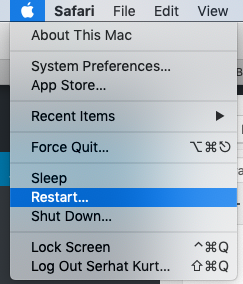To use any of these key combinations, press and hold the keys immediately after pressing the power button to turn on your Mac, or after your Mac begins to restart. Keep holding until the described behaviour occurs.
How to Exit Safe Mode. To leave safe mode, do the following: 1. Restart your Mac without pressing keys on startup. Select “Apple menu Shut Down.” This will return you to your desktop in normal mode. Note: Exiting safe mode may take longer than booting in normal mode. Be patient and don’t interrupt the process or hard-reset your Mac.
- Command (⌘)-R: Start up from the built-in macOS Recovery system. Or use Option-Command-R or Shift-Option-Command-R to start up from macOS Recovery over the Internet. macOS Recovery installs different versions of macOS, depending on the key combination you use while starting up. If your Mac is using a firmware password, you're prompted to enter the password.
- Option (⌥) or Alt: Start up to Startup Manager, which allows you to choose other available startup disks or volumes. If your Mac is using a firmware password, you're prompted to enter the password.
- Option-Command-P-R:Reset NVRAM or PRAM. If your Mac is using a firmware password, it ignores this key combination or starts up from macOS Recovery.
- Shift (⇧): Start up in safe mode. Disabled when using a firmware password.
- D: Start up with the Apple Diagnostics utility. Or use Option-Dto start up this utility over the Internet. Disabled when using a firmware password.
- N: Start up from a NetBoot server, if your Mac supports network startup volumes. To use the default boot image on the server, hold down Option-N instead. Disabled when using a firmware password.
- Command-S: Start up in single-user mode. Disabled in macOS Mojave or later, or when using a firmware password.
- T: Start up in target disk mode. Disabled when using a firmware password.
- Command-V: Start up in verbose mode. Disabled when using a firmware password.
- Eject (⏏) or F12 or mouse button or trackpad button: Eject removable media, such as an optical disc. Disabled when using a firmware password.
If a key combination doesn't work
The settings stored in NVRAM remain in place even after you reboot your Mac. Problems, such as continued booting in Safe Mode, happen when one of these settings gets corrupted or changed. What you need to do is reset the NVRAM/PRAM on your Mac. To do this, follow these steps: Restart your Mac. Hold down this keyboard combination: Cmd + Option + R. Choose Another Startup Disk with the Startup Manager. To boot from a specific device. Safe mode: shift. Safe mode is a way of starting up your Mac that makes sure it performs.
Safe Restart Macbook
If a key combination doesn't work at startup, one of these solutions might help:

Mac Boot Up Keys

- Be sure to press and hold all keys in the combination together, not one at a time.
- Shut down your Mac. Then press the power button to turn on your Mac. Then press and hold the keys as your Mac starts up.
- Wait a few seconds before pressing the keys, to give your Mac more time to recognise the keyboard as it starts up. Some keyboards have a light that flashes briefly at startup, indicating that the keyboard is recognised and ready for use.
- If you're using a wireless keyboard, plug it into your Mac, if possible. Or use your built-in keyboard or a wired keyboard. If you're using a keyboard made for a PC, such as a keyboard with a Windows logo, try a keyboard made for Mac.
- If you're using Boot Camp to start up from Microsoft Windows, set Startup Disk preferences to start up from macOS instead. Then shut down or restart and try again.
Remember that some key combinations are disabled when your Mac is using a firmware password.
Learn more
Reboot Imac In Recovery Mode
- Find out what to do if your Mac doesn't turn on.
- Find out about Mac keyboard shortcuts that you can use after your Mac has started up.
